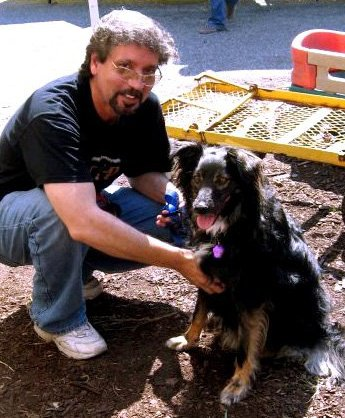Welcome to the third post in our six-part series: Difficult, Aggressive Dogs Need Strong Training. Really?
John Visconti continues his story about rehabilitating and training Pepper, the dog-aggressive, stranger-aggressive, resource guarding, and thunder phobic pooch he adopted from a local shelter.
One of the many reasons I’m delighted and privileged to share John’s and Pepper’s journey with you is that their success challenges a prevailing belief in the dog world that there’s a special class of aggressive, reactive dogs, of which Pepper is surely one, that require “strong handling,” or the use of aversives, in order to be rehabilitated.
A corollary to this misguided notion is that positive trainers are just “treat dispensers” or “cookie pushers.” They don’t train dogs, they bribe them with food. They’re easy. Soft. Permissive. Fido is in charge, not the trainer. If positive methods are effective at all, they work only with compliant, easy dogs, not “red-zone dogs.”
No doubt there are some trainers who do not effectively apply the principles of learning theory and positive reinforcement.They don’t get solid, reliable behaviors without ongoing clicks and treats.
John is not one of those trainers.
Part 3. POSITIVE DOES NOT MEAN PERMISSIVE
The most force I used with Pepper was to occasionally block her. Period. No chokers, prongs, shocks. No aversives.
While my training methods and beliefs are all based in positive reinforcement techniques, that doesn’t mean I’m easy. In fact, I was more demanding of her than any “correction” based trainer I know.
My goal was to show her that her old coping mechanisms didn’t translate well into her new home. AND to also coach her to establish new behaviors to replace the old.
My biggest problem with aversive training methods is that too often, the methods are focused on stopping a behavior rather than replacing it with a desired one. Leaving it up to Pepper to decide on a new behavior was not my idea of leadership.
I also recognized this was going to be hard work for her. I don’t work for free. Nor does anyone else. We get paychecks at the end of the week. I’d like to see a show of hands from those who would answer the question, “How many of you work for you boss because you want to please him rather than a paycheck?”
The most potent rewards I used were provided by things Pepper wanted in her environment. A romp in the backyard chasing after scents left behind by demon squirrels, is much more rewarding that a piece of freeze dried liver. Pepper also has a love for sticking her head down into a sewer to sniff out whatever vermin has been there within the past decade.
In all cases, anything that I learned was a reward for her became accessible to her only after she performed a cued behavior. “Watch” and then I’d allow her to run around in the backyard. “Head’s up” as we approached a sewer, followed by “wait.” Then we’d run to the sewer. ”
Once I got her home, for subsequent months, I had a zero tolerance policy, meaning, if she didn’t perform a learned behavior on cue exactly, she didn’t receive any reinforcement and she had to repeat the behavior. And when I say “exactly” I do mean exactly. If I wanted her to “sit-stay” at the garage door before coming into the car with me and she inched forward before I cued her to come, she was placed a bit further away and cued to sit-stay again. There would be plenty of time to loosen the reigns later on.
She learned, very early on, that I was in charge of all the resources she needed to live and to also have fun in her life. I am not sure why some trainers believe in causing physical discomfort with their dogs or why they see some dogs in one light and others in another. Fact is, we are in control of EVERYTHING that the dog needs to live. If that isn’t enough to establish leadership, what is?
Pepper’s first 36 hours in my home were spent leashed to me. This included two nights of sleep.
For the first two weeks, she ate all meals out of my hand (To this day, each meal starts with one spoonful by hand.) and only after responding to a basic cue like “sit”. Actually, “sit” was the only cue she knew when I brought her home.
She was restricted to certain areas of the house. She didn’t get full run of the house for a few weeks.
Much of my training of other cues had to be delayed because my initial months with her were spent desensitizing and counter-conditioning.
Separation Anxiety
At this point, we started working on her moderate separation anxiety issues.
While shelter life was anything but great, there’s always company and noise in a shelter. Not so when I would leave her alone in my home. Like anything else we did, this was an incremental process.
I didn’t allow her to establish any associations to triggers like keys or my putting on my jacket. I made sure to jumble up all of my usual routines. I would, toss a few treats, or give her a Kong, and calmly, silently, leave the house for 30 seconds open my car door, get inside, shut it, start the engine pull out of the drive way, then pull back in, shut the engine off and come back in.
All the while, I could hear her barking. She’d anxiously be jumping at the gate in her room when I entered the house. She’d get a very calm “hello” from me and a “sit” cue. When she complied, I’d open the gate and let her join me.
We practiced for longer and longer durations, and she became calmer with each passing day. Then one day, I came home and she didn’t run to the gate to meet me. Instead, she was on her bed. Upon seeing me, Pepper did the l-o-n-g-e-s-t stretch I’ve ever seen, and calmly strolled to the gate. Separation anxiety under control.
I am careful to this day with her about my coming and going as I’ve noticed she can still be predisposed to showing anxiety when I leave.
As an aside, I think dog owners are very often too quick to assume a behavior has been learned simply because they see a behavioral change, or a new behavior being performed on cue. Learning doesn’t take place until we see many repetitions of the cued behavior. In fact, I never assume behavioral changes are permanent. Maintenance is always part of training.
At the same time, we began working on her resource guarding.
Part 4 of John’s and Pepper’s story will be posted on Friday, April 8, 2011.
See you then!
——————————————
Previous posts in this series:
Part 1: Difficult, Aggressive Dogs Need “Strong” Training. Really? (John’s story: John Meets Pepper)
Subsequent posts in this series:
Part 4: Difficult, Aggressive Dogs Need “Strong” Training. Really? (John’s story: Resource Guarding? Biting? Dog-dog Agression? No Sweat.)












I am so glad you’re posting this series. Fantastic message and a really thoughtful analysis of the benefits of positive training.
Thank you so much. And, thanks to John for his great writing and his work with Pepper.
🙂 Thank you for the VERY kind words
John
Underline “never assume behavioral changes are permanent.Maintainence is always a part of training.”As an owner of a human and dog aggressive rescue dog this line really hits home.Just like ex-smokers and ex-alcoholics it is very easy for our dogs to slip into old and well learned old patterns of behavior.This is one of the best writing I come across on this topicThank you Deborah and John.
Thank you, Susan.
Thanks for the very kind words. 🙂
I have custom made t shirts….one picture on them…no words.
The picture is of a nail, with just the tip driven into a fence post.
I ask my customers “Do you think this nail would support a heavy hanging planter?”
“Of course not.”
I then remind them that just because their dog has given them a behavioral change a few times, or has performed a new cue a handful of times, doesn’t mean that the behavior has been learned and that we can now comfortably begin to “hang things” on the behavior.
“Keep hammering out repetitions” is my repeated Mantra.
John
Everything that John writes makes so much sense, but perhaps my favorite lines (because they’re such great responses to people who dismiss “reward” training) are:
I’d like to see a show of hands from those who would answer the question, “How many of you work for you boss because you want to please him rather than a paycheck?”
And
Fact is, we are in control of EVERYTHING that the dog needs to live. If that isn’t enough to establish leadership, what is?
I liked those lines also. They drive the point home.
Thanks for the kind words, Edie.
Yep. I ask that all the time….especially of those who say “I want the dog to want to do it for me”..or..”He’s only doing it for the reward”.
“I want you to envsion your boss. It’s payday. He/she walks up to you, without a pay check, pats you on the back and says ‘Thanks, great job this week’ and then walks away without giving you a paycheck” How motivated would you be?”
As far as controlling all the resources, it’s a nice, sorta nonconfrontational way to challenge someone who believes in aversives. I play it out on their turf by letting them know that I agree, leadership is very important. And then I pose the question…”You’re in control of the dog’s food….water…ability to go outside…” etc etc….”isn’t that enough to establish who’s in charge?”
🙂
Hey Deborah, I just wanted to let you know how much I’m enjoying this series. I think it’s important to challenge the mindset that for some dogs aversive training is all that will work.
I’m so glad you’re enjoying the series. Thanks!
Thanks Amy, very kind of you. 🙂
John
Great series! Thank you to both Deborah and John. Inspiring story for someone who deals with a leash reactive dog. I always remind myself that while she may not have reacted in a few weeks, I should always be prepared and set her up to succeed by not putting her in a situation where she is likely to regress.
Thanks for the kind words, Patty.
Pepper was very leash reactive. My knee, which she tore while lunging at another dog that was 150+ feet away, can attest to that.
She does a great “watch” and an equally good “head’s up” which is a watch cue while moving.
The trick in training her was to be able to anticipate her reactivity and catch it before it happened by cueing one of the above cues and then rewarding. I didn’t want to cue her after she reacted out of concern that she’d think “I react, then I watch” was an acceptable behavior chain.
At times when I knew she wasn’t comfortable, I’d cue “watch” and when she made eye contact, we’d dash off running away from the other dog. I think, in the beginning, this was a better pay off than treats. The entire neighborhood thought I was nutz but hey, that’s fine.
Just a hunch but the occasional “regression” might not be the worst thing in the world because it serves as a differentiator. Reaction = no reward. So long as it doesn’t become something that is self reinforcing…I don’t concern myself too much with the occasional slip. And ya know, I assume that on occasion, maybe the other dog did something rude. If I’m driving and someone cuts me off, I have a reaction.
Just sharing some thoughts. I never assume I “know”. I just like to dialogue with people about our approaches.
Thanks
John
Nice to know that real men toss cookies too. 😉 Or in this case, run into sewers.